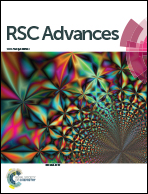β-NiMoO4 nanowire arrays grown on carbon cloth for 3D solid asymmetry supercapacitors†
Abstract
Based on β-NiMoO4 nanowire (NW) arrays grown on carbon cloth as the electrode materials, a 3D solid asymmetrical supercapacitor has been fabricated. The produced β-NiMoO4 NW arrays on carbon cloth compared to the power of NiMoO4 nanowires deposited directively on carbon cloth can increase the efficiency of nanomaterials participating in reactions. The cone-shaped NW arrays have a high specific surface area (99 m2 g−1), which can provide more electroactive sites for Li+ and enhance conductivity through providing short transport and diffusion paths for both ions and electrons. And the cylindrical supercapacitor can allow more β-NiMoO4 NW arrays to saturate with electrolyte to enhance the properties of the supercapacitor. Furthermore, the electrode has a highest energy density of 36.86 W h kg−1, a maximum power density of 1100 W kg−1, and a large capacitance of 414.7 F g−1 at a current density of 0.25 A g−1, all of which demonstrate excellent behavior. And the capacitance of the supercapacitor reached 65.96% of the initial capacitance over 6000 cycles. All of these results indicated that the β-NiMoO4 NW arrays grown on carbon cloth could be a promising candidate for high performance supercapacitors.


 Please wait while we load your content...
Please wait while we load your content...